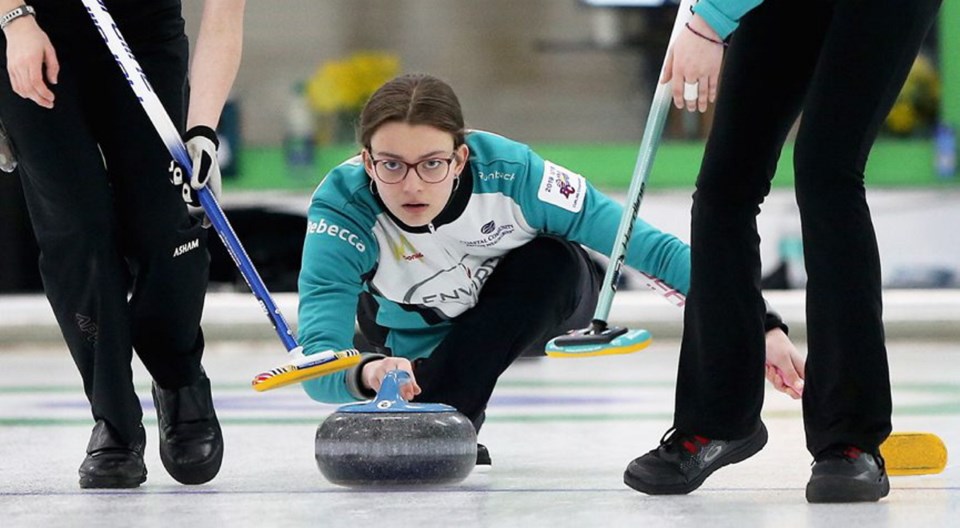The Juan de Fuca Curling Club opened in 1975 when the local WHL team was the Cougars, the other Trudeau was Prime Minister, Gerald Ford was in the White House and Jaws in movie houses terrorizing audiences.
The last winners to emerge out of the facility Sunday were Eric Colwell and Kaila Buchy, whose rinks won their respective titles in the well-staged 2019 B.C. U-18 boys’ and girls’ championships.
On Monday, the Juan de Fuca Club received notification from West Shore Parks and Recreation that curling ice would no longer be provided in order to make more dryland space in the facility. The decision is permanent and has not gone down well with the curlers.
“After 44 years of connections and relationships, we’re all reeling from this. It’s heartbreaking,” said Pei Mei Chia, president of the 520-member Juan de Fuca Curling Club.
“West Shore Parks and Recreation could have handled it better. We got an email a day after hosting a highly-successful provincial U-18 championship. It was poor timing, and with a heavy-handed top-down approach, with no consultation with us, or input from us. It’s not fair.”
Jonathan Huggett, project consultant on this file for West Shore Parks and Recreation, believes curling is a receding sport and that better uses can be made of the space it occupies in the recreation centre.
“Curling is not growing in popularity. It is declining. And there is a huge demand for dryland space,” said Huggett.
WSPR said the curling rink is booked only 20 per cent of available time and sits unused for the other 80 per cent.
Management also released statistics which indicate curlers are subsidized more than any other user group at WSPR facilities.
“These low [curling] participation and usage rates translate into high operating costs,” said a WSPR statement.
“For each person that comes to curl, West Shore Parks and Recreation must pay an additional $11.24 to sustain the facility and operations. In comparison, the subsidy per usage for the Juan de Fuca Arena is $4.26 and the Juan de Fuca Pool is $2.07.”
The curling subsidy is “way out of proportion,” said Huggett.
“It’s a no-brainer [to take away the curling ice] and should have been done long ago,” he added.
“It was not good value for taxpayers’ dollars.”
WSPR also pointed out that only 50 per cent of the Juan de Fuca Club curlers lived in the five West Shore communities that pay for the subsidy. The other 50 per cent of the JDF curlers were from other areas of Greater Victoria.
Huggett said there is increasing demand from all kinds of team sports for the curling space. The issue of what sort of dryland floor will replace the curling ice is to be decided. He said the choices are concrete, turf, wood or plastic sports floor.
“We will look at what type of floor will get the most usage,” said Huggett.
He added the current curling lounge, “which was rarely used,” will be repurposed as day-care space “which is much in demand.”
With Juan de Fuca following the closing of the Glen Meadows curling facility last year, the Capital region has lost 14 sheets of ice in two years, leaving a total of 14 remaining between the Victoria and Esquimalt curling clubs. The question now is whether Victoria and Esquimalt can absorb the Juan de Fuca curlers.
“It will not be an issue in the daytime, but could be at nighttime, where we are chock-a-block full with few exceptions,” said Paul Dixon, general manager of the 800-member Victoria Club.
“We may need to get creative, like expanding from two evening draws to three. This is not great for the curling community. It’s frustrating. I hate to see clubs closing.”
There appears to be more leeway over the bridge.
“We certainly have some room and are willing to help the best we can,” said Samantha Sherman, president of the 500-plus Esquimalt Curling Club.
“We are looking to use as much ice as we can and it’s great to have new curlers. We are looking to fill leagues and can add draws and leagues.”
In the latest Curling Canada figures available, national participation dropped by 19,000 from 729,000 in 2008 to 710,000 in 2014. That decline is thought to have continued to currently just below 700,000.
In a major issue for the sport nationwide, only 18 of the Juan de Curling Club’s 520 participants are youth members.
“Most of our members are seniors, too,” said Sherman, of the similar situation in the Esquimalt Club.
“We want to get more young people into it. Curling Canada wants to keep the sport alive. The Olympics help.”
Perhaps because of its location, and the condo boom downtown attracting a younger demographic population, Victoria Club appears to be bucking the trend of youth bucking the sport.
“We’re seeing younger people coming in who are curling for fun as opposed to [competitively],” added Dixon.
That, however, might be a downtown-specific and hipster-activity outlier in an otherwise aging curling landscape.
But Juan de Fuca club president Chia said she doesn’t buy into the curling-as-a-declining-sport narrative and pointed to continuing strong TV numbers for the sport.
TSN reported an overall average viewing audience this year of 378,000 for the Brier, the Canadian men’s championship, and 351,000 for the Scotties Canadian women’s championship and 659,000 viewers for the Brier final and 762,000 for the Scotties final.
This year’s Brier average of 378,000, however, compares to 587,000 in 2016.
Regardless of the state of the game, Juan de Fuca members are unhappy about the suddenness of their club closing this week.
“There was no [prior] notification and no heads-up,” said Chia.
“If they had told us at the beginning of the season, not the end of the season, we still would not have been in agreement with the decision, but would at least have had time to prepare.”
Dixon said Victoria Club is responding to the situation by opening registration earlier this summer for next curling season.



